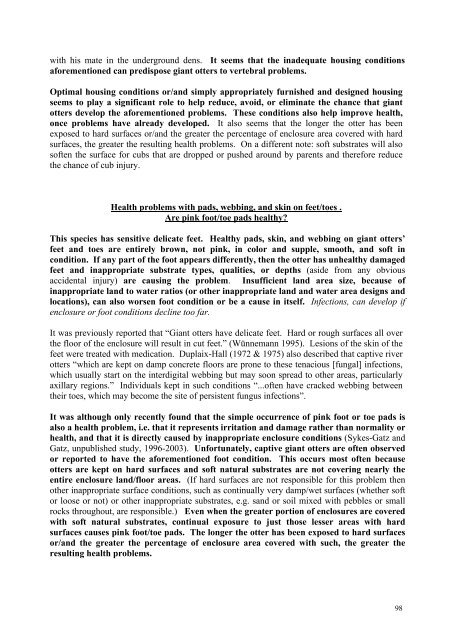International Giant Otter Studbook Husbandry and Management
International Giant Otter Studbook Husbandry and Management
International Giant Otter Studbook Husbandry and Management
You also want an ePaper? Increase the reach of your titles
YUMPU automatically turns print PDFs into web optimized ePapers that Google loves.
with his mate in the underground dens. It seems that the inadequate housing conditions<br />
aforementioned can predispose giant otters to vertebral problems.<br />
Optimal housing conditions or/<strong>and</strong> simply appropriately furnished <strong>and</strong> designed housing<br />
seems to play a significant role to help reduce, avoid, or eliminate the chance that giant<br />
otters develop the aforementioned problems. These conditions also help improve health,<br />
once problems have already developed. It also seems that the longer the otter has been<br />
exposed to hard surfaces or/<strong>and</strong> the greater the percentage of enclosure area covered with hard<br />
surfaces, the greater the resulting health problems. On a different note: soft substrates will also<br />
soften the surface for cubs that are dropped or pushed around by parents <strong>and</strong> therefore reduce<br />
the chance of cub injury.<br />
Health problems with pads, webbing, <strong>and</strong> skin on feet/toes .<br />
Are pink foot/toe pads healthy?<br />
This species has sensitive delicate feet. Healthy pads, skin, <strong>and</strong> webbing on giant otters’<br />
feet <strong>and</strong> toes are entirely brown, not pink, in color <strong>and</strong> supple, smooth, <strong>and</strong> soft in<br />
condition. If any part of the foot appears differently, then the otter has unhealthy damaged<br />
feet <strong>and</strong> inappropriate substrate types, qualities, or depths (aside from any obvious<br />
accidental injury) are causing the problem. Insufficient l<strong>and</strong> area size, because of<br />
inappropriate l<strong>and</strong> to water ratios (or other inappropriate l<strong>and</strong> <strong>and</strong> water area designs <strong>and</strong><br />
locations), can also worsen foot condition or be a cause in itself. Infections, can develop if<br />
enclosure or foot conditions decline too far.<br />
It was previously reported that “<strong>Giant</strong> otters have delicate feet. Hard or rough surfaces all over<br />
the floor of the enclosure will result in cut feet.” (Wünnemann 1995). Lesions of the skin of the<br />
feet were treated with medication. Duplaix-Hall (1972 & 1975) also described that captive river<br />
otters “which are kept on damp concrete floors are prone to these tenacious [fungal] infections,<br />
which usually start on the interdigital webbing but may soon spread to other areas, particularly<br />
axillary regions.” Individuals kept in such conditions “...often have cracked webbing between<br />
their toes, which may become the site of persistent fungus infections”.<br />
It was although only recently found that the simple occurrence of pink foot or toe pads is<br />
also a health problem, i.e. that it represents irritation <strong>and</strong> damage rather than normality or<br />
health, <strong>and</strong> that it is directly caused by inappropriate enclosure conditions (Sykes-Gatz <strong>and</strong><br />
Gatz, unpublished study, 1996-2003). Unfortunately, captive giant otters are often observed<br />
or reported to have the aforementioned foot condition. This occurs most often because<br />
otters are kept on hard surfaces <strong>and</strong> soft natural substrates are not covering nearly the<br />
entire enclosure l<strong>and</strong>/floor areas. (If hard surfaces are not responsible for this problem then<br />
other inappropriate surface conditions, such as continually very damp/wet surfaces (whether soft<br />
or loose or not) or other inappropriate substrates, e.g. s<strong>and</strong> or soil mixed with pebbles or small<br />
rocks throughout, are responsible.) Even when the greater portion of enclosures are covered<br />
with soft natural substrates, continual exposure to just those lesser areas with hard<br />
surfaces causes pink foot/toe pads. The longer the otter has been exposed to hard surfaces<br />
or/<strong>and</strong> the greater the percentage of enclosure area covered with such, the greater the<br />
resulting health problems.<br />
98

















